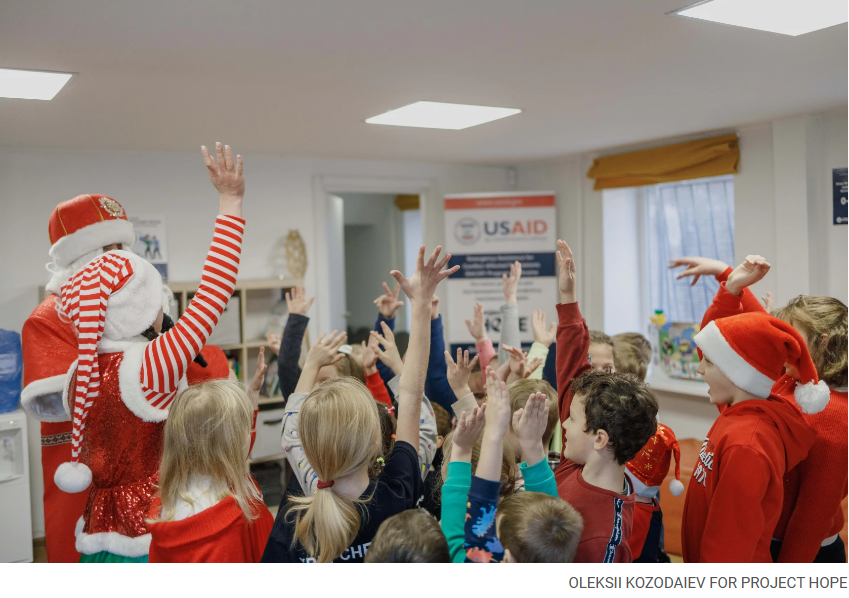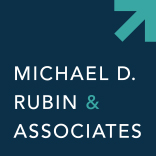Some nonprofits are sharing blunt messages about financial woes in an effort to spur donations.
By Emily Haynes
December 11, 2023
philanthropy.com

Children celebrate St. Nicolas Day in Dnipro, Ukraine, on Dec. 5, as part of a program partly funded by nonprofit Project HOPE. The group is appealing to supporters with donor-advised funds in its year-end campaign.
Nonprofit fundraisers are now in the thick of the all-important year-end fundraising period, when many groups raise the bulk of their annual revenue. After an unimpressive fundraising finish last year, charities are hoping for a better outcome this year.
But the calendar year’s final fundraising push comes on the heels of a lackluster GivingTuesday, where donor participation fell 10 percent and total giving stayed flat at $3.1 billion. But that outcome doesn’t mean year-end giving will also be flat, according to Laura MacDonald, principal at Benefactor Group, a fundraising consulting firm.
“I don’t think it’s a good indication of the sentiment of high-net-worth donors,” she says. That’s because GivingTuesday typically appeals to donors giving small sums. Major donors, she says, are generally more responsive to the highs and lows of the stock market, giving more when the market soars and giving less when it falters.
However, the decline in participation seen on GivingTuesday worries MacDonald. While it’s not yet clear why fewer donors joined in this year, she says it’s “continued evidence of the troubling trend that we’ve been seeing for a while, which is the declining rate of participation in charitable giving in America.”
With the loss of these everyday givers, high-net-worth donors have been powering donations in recent years. This year-end, these big donors are expressing more confidence in giving than they did last year, says Chris Collins, director of national philanthropy at Genesys Works, a nonprofit that places high schoolers in paid corporate internships. That could be due to improved stock market performance and the fact that a full-blown recession never materialized in 2023, he says.
“There’s just a little bit more of a sense of optimism,” he says, “and maybe more of a willingness to make larger philanthropic investments.”
In a bid to make this year-end better than the last, fundraisers are shaking things up by appealing for gifts via donor-advised funds and making their budget needs plain to donors.
All Eyes on DAF Contributions
At Project HOPE, an international-aid nonprofit, fundraisers are encouraging donors to consider making contributions from their donor-advised funds this year. The charity is running a social media campaign asking donors, “Have you done a health check on your DAF lately?” Fundraisers will also discuss gifts from donor-advised funds when they talk to donors at year-end. Direct mail and email marketing will also mention these gifts.
The nonprofit raises roughly 40 percent of its revenue in the last two months of the year, according to Cinira Baldi, its chief development and communications officer.
“It’s really critical that people understand that we rely on their donation preemptively, before the emergency even occurs, so that we can respond quickly,” she says. “Having funding that is not available because it’s tied up in DAFs really creates constraints for any of the NGOs who are responding to the urgent [crises] around the world.”
Project HOPE is making this appeal as more donors are choosing to put their money in donor-advised funds. In 2021, giving to donor-advised funds outpaced giving to private foundations, according to the Institute for Policy Studies research project, Inequality.org.
Baldi says Project HOPE earned $3.5 million in fundraising revenue from contributions via donor-advised funds last year.
Given the popularity of donor-advised funds, Baldi says it’s tricky to make the pitch to donors to disburse money out of them — not just put money into them. “It’s a fine line. You don’t want donors to ever feel like what they’re doing with their money is not smart,” she says. The charity’s campaign focuses on boosting donors’ awareness of how they can be involved in giving from their DAFs, with the hope that the knowledge will inspire them to make a contribution.
Collins at Genesys Works says this year he has tried to build relationships with community foundations in the seven regions where his nonprofit operates. “We’ve found the sweet spot is just being on the radar of community foundations and [DAF] providers,” he says. That way if a DAF holder expresses an interest in making a grant toward workforce development, the community foundation can point them toward Genesys Works.
Donor-advised fund contributions to Year Up, a nonprofit that provides career training and mentorship for low-income young adults, have quadrupled since 2020, according to Susan Murray, its national director of corporate engagement, development, and revenue operations. While gifts from DAFs are notoriously hard to trace, Murray’s team does “very unsexy operational work” to uncover the donors behind those gifts, as long as they haven’t asked to be anonymous.
If fundraisers know a donor has previously given through a certain DAF provider, for example, they might confirm with the donor that a recent check from that provider was from their fund. Some checks from DAF providers will give the name of the donors who opened the funds. Others will include cover letters identifying the donor and requesting a report on how the gift was used. When checks contain no donor information at all, fundraisers will sometimes ask the fund’s sponsor whether the donor wanted to share more information about themselves so that they could receive a thank-you note or other communication. While Murray says this doesn’t always yield more information on the donor, it sometimes does.
“At least we tried,” she says. “We don’t want someone to give to us, and we don’t say thank you, and they wanted us to — a fundraiser’s worst nightmare.”
Appeals Get Real
Some nonprofits aren’t sugar coating their budget needs this year-end, in hopes of encouraging donors to open their pocketbooks. YES!, a nonprofit media organization that publishes stories about solutions to big issues, notified supporters on October 12 that it was letting go of five staff members and cutting its budget by a quarter.
“We’ve experienced a double hit with declines in individual donations, and in print subscriptions (a trend that started a decade ago and accelerated last year), which together make up 60% of our revenue,” reads an email signed by the organization’s senior leaders.
The magazine announced a year-end fundraising goal of $350,000.
Vermont local nonprofit news site VTDigger also noted its tough financial situation this year-end. The nonprofit’s resources were strained in July when it produced round-the-clock coverage of severe flooding throughout the state. The rising waters also damaged the outlet’s office in Montpelier — which experienced some of the worst flooding — and forced the newsroom to relocate.
“We want to be direct: Due to a number of factors, 2023 was a difficult financial year for us, and we need help to continue the level of coverage you’ve come to expect from VTDigger,” Chief Operating Officer Sky Barsch wrote in a November 14 email to readers. The nonprofit hopes to raise $550,000 to advance its journalism.
One reason some nonprofits are getting more candid could be the declining rates of mid-level giving, says fundraising consultant Michael Rubin. With fewer donors giving overall, nonprofits are trying to hit home the difference everyday donors can make.
“In general, I always think transparency is a good thing, as long as you’re not complaining to people that you don’t know how to run a good organization,” Rubin says. “Because I don’t think that that resonates very well with donors.”
Appeals that emphasize the impact a nonprofit makes are typically most compelling, according to Rubin. As an example, he points to public radio’s shift in tone from almost desperate appeals to help stations stay on the air 10 or 20 years ago to today’s more sophisticated pledge drives that emphasize how donors benefit from the organization’s coverage.
“Donors want to be associated with successful organizations,” he says, “however you define that.”
